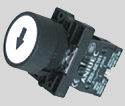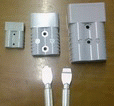Split Core CT Current Transformer
 Split core current transformers have interleaved joint and hinge structure.
Split core current transformers have interleaved joint and hinge structure.Split core CTs have a removable section, so that they can be installed without interrupting the circuit.
A split core current transformer for coupling monitoring apparatus to a current carrying conductor includes a two-piece annular core structure formed by first and second arcuate core assemblies having windings, connectable to the monitoring apparatus, wound on laminated core sections, the laminated core sections each including a plurality of flat lamination elements arranged in a stacked configuration with alternate elements having generally circular end portions which project beyond the main body portion of the arcuate core section at each end thereof defining generally circular gaps....

Technical Details of split core transformers
Primary current: 100A-5000ASecondary current: 5A, 1A
Standard approval: IEC44-1, BS7626
Maximum voltage: 0.72/3kV
Frequency: 50/60Hz
Rated load: 1VA-30VA
Class: 0.5, 1.0, 3.0
Short-time thermal current: Ith=100ˇÁIn
Rated security coefficient: FS
Type |
A |
B |
C |
D |
E |
F |
G |
H |
I |
Weight(kg) |
DP-23 |
20 |
30 |
51 |
89 |
111 |
34 |
47 |
40 |
32 |
0.75 |
DP-58 |
50 |
80 |
78 |
114 |
145 |
32 |
32 |
32 |
33 |
0.90 |
DP-88 |
80 |
80 |
108 |
144 |
145 |
32 |
32 |
32 |
33 |
1.05 |
DP-812 |
80 |
120 |
108 |
144 |
185 |
32 |
32 |
32 |
33 |
1.25 |
DP-816 |
80 |
160 |
120 |
184 |
245 |
52 |
47 |
52 |
38 |
4.30 |
| split-core size | (AxB) |
| DP-23 | 20x30mm |
| DP-58 | 50x80mm |
| DP-88 | 80x80mm |
| DP-812 | 80x120mm |
| DP-816 | 80x160mm |


Type |
Primary (A) |
|
CL :
0.5 |
||
VA |
||
DP-23
|
100 |
- |
150 |
- |
|
200 |
- |
|
250 |
- |
|
300 |
1.5 |
|
400 |
2.5 |
|
DP-58 |
250 |
1.5 |
300 |
1.5 |
|
400 |
1.5 |
|
500 |
2.5 |
|
600 |
2.5 |
|
750 |
2.5 |
|
800 |
2.5 |
|
1000 |
5 |
|
DP-88 |
250 |
1.5 |
300 |
1.5 |
|
400 |
1.5 |
|
500 |
2.5 |
|
600 |
2.5 |
|
750 |
2.5 |
|
800 |
2.5 |
|
1000 |
5 |
|
DP-812 |
500 |
2.5 |
600 |
2.5 |
|
750 |
2.5 |
|
800 |
2.5 |
|
1000 |
5 |
|
1200 |
6 |
|
1250 |
7.5 |
|
1500 |
7.5 |
|
DP-816 |
1000 |
10 |
1500 |
15 |
|
2000 |
15 |
|
2500 |
15 |
|
3000 |
20 |
|
4000 |
20 |
|
5000 |
20 |
Type |
A |
B |
C |
D |
E |
F |
G |
H |
I |
Weight(kg) |
DP-23 |
20 |
30 |
51 |
89 |
111 |
34 |
47 |
40 |
32 |
0.75 |
DP-58 |
50 |
80 |
78 |
114 |
145 |
32 |
32 |
32 |
33 |
0.90 |
DP-88 |
80 |
80 |
108 |
144 |
145 |
32 |
32 |
32 |
33 |
1.05 |
DP-812 |
80 |
120 |
108 |
144 |
185 |
32 |
32 |
32 |
33 |
1.25 |
DP-816 |
80 |
160 |
120 |
184 |
245 |
52 |
47 |
52 |
38 |
4.30 |
Quotation of Split Core Transformers
Defination of Split-Core CT Current Transformers
Just like the typical current transformer, the split-core current transformer measures alternating current flowing through a conductor.The distinguishing feature of the split core current transformers is that their design permits them to be assembled around a buss barwithout disconnecting the buss bar. The typical current transformer is usually a toroidal coil, which is slipped over the end of a buss bar, hence requires disconnecting the buss bar.
"C" - cores and "U" core structures are commonly used for split-core current transformers because they are relatively easy to take apart and put back together around the buss bar. Some sort of bracketry or band clamps and holds the assembled pieces of the split-core current transformer together. Historically, this has not been as practical ( but is possible ) for toroidal coils. The bracketry is more complicated. Typically, the coil(s) must be sector wound on the toroid before cutting the core in half, whereas the “U?and “C?core structure of the typical split-core current transformer permit use of bobbin wound coils which can be wound independently of the core. There are now some flexible toroids, which permit the “split-core?feature of installing it around a buss bar.
Split-core current transformers for lower frequency applications ( power frequencies ) typically use grain oriented silicon steel or nickel alloys for the core material. There are some more exotic materials available. The material is cut into strips and then wound on an arbor ( mandrel ) to form a core. The core is then cut in half. These are known as “tape-wound?cores because their construction resembles a roll of tape.






